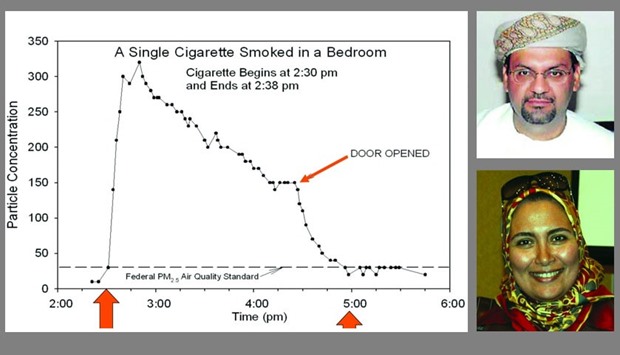"There is no safe level of exposure to second?hand smoke," Dr Fatimah El-Awa, regional advisor, Tobacco Free Initiative, WHO-EMRO, told Gulf Times, quoting the relevant article from the FCTC.
“Parties of the FCTC recognise that scientific evidence has unequivocally established that exposure to tobacco smoke causes death, disease and disability,” she explained.
“The opinion of the FCTC is that all
indoor areas must be 100% smoke free. Allowing designated smoking areas inside buildings, is a breach of Article 8,” highlighted Dr Jawad al-Lawati, senior consultant, ministry of health, Oman.
At many public buildings in Qatar and the rest of the GCC region, it is a common practice to provide designated smoking areas – a closed area within the buildings - for smokers. However, several studies have proved that tobacco smoke continues to linger all over the place for very long hours and can harm others.
Dr al-Lawati pointed out: “Scientifically, you need a fan as powerful as a tornado to expel tobacco smoke from any indoor area. But, it is the national law that the local court takes into account.”
Narrating a personal experience, Dr El-Awa pointed out that any area filled with cigarette smoke can discolour teeth and skin and create breathing trouble for some people.
“I found myself with blackened teeth when I went to brush after staying in a hotel room which was occupied previously by a tenant who was a chain smoker,” she remarked.
According to Dr El-Awa, second-hand smoke is not only harmful to health; it kills. “Nearly 600,000 people die each year from exposure to second-hand smoke. Every major scientific body in the world, including WHO, and other leading agencies state that it is a serious health threat and a significant cause of death and disease.”
“The list of diseases and adverse health effects from exposure to second?hand smoke is long and growing, and includes cancer, heart disease, stroke and sudden infant death syndrome. There are at least 69 established cancer?causing chemicals in tobacco smoke, and hundreds of recognised human toxins. No level of exposure is safe,” Dr al- Lawati observed.
Ventilation systems and air purifying technologies are not only expensive but also incapable of eliminating exposure to second-hand smoke, he added.



